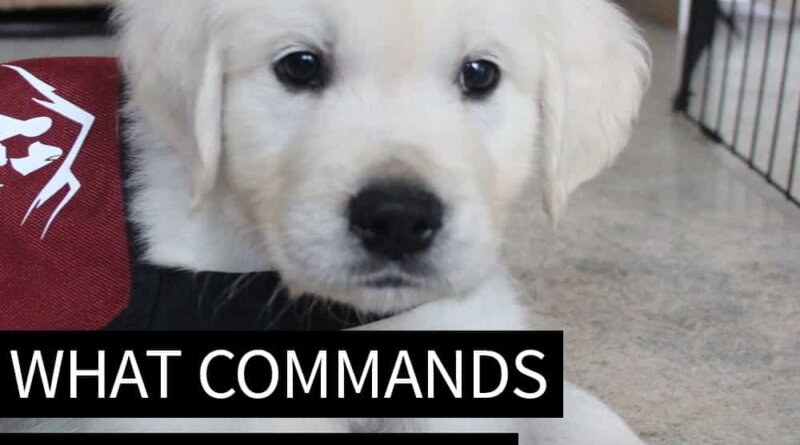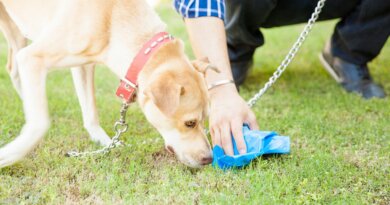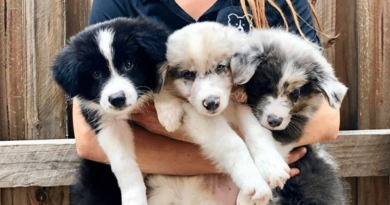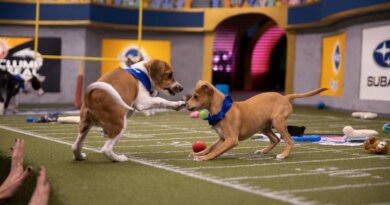What Commands Do You Teach A Service Dog?
This post may contain affiliate links. We may earn money or products from the companies mentioned in this post.

Have you ever wondered or thought to ask: “Colby, what commands do you teach a service dog?”
As guide dog puppy raisers we teach our puppies 9 basic obedience commands before they start their formal training.
Adelle’s service dog training manual lists 30 commands! That’s right THREE – ZERO!!!
We’ve been raising and training guide dog puppies since 2006 and we have the privilege of working with these puppies from the time they are 8 weeks old until they are 18 months.
During this time we do our best to make sure they are rock solid with a handful of commands.
When our pups move on to guide dog college they learn many more commands as well as advanced skills and intelligent disobedience.
QUICK RECOMMENDATION: Unfortunately, if you’re not a puppy raiser then you likely do not have access to a service dog training manual. However, there are many good puppy training books available. One of our favorite books is Puppies for Dummies. We read Puppies for Dummies several times before we adopted our first puppy, Linus.
What Do We Teach Our Service Dog Puppies In Training?
As a puppy raiser we do not teach our puppies everything. We have three main goals as puppy raisers:
- Teach our pups good house manners.
- Socialize our puppies.
- Teach them basic obedience.
The basics are the same whether you are a guide dog puppy raiser or a service dog puppy raiser. As mentioned earlier the big difference is we have to teach our service dog puppies 30 commands vs only 9 for our guide pups.
That’s right! Canine Support Teams has a list of 30 commands we are tasked to teach our service dog puppies in training.
In fact, learning how to teach these different commands is one of the main reasons why I was interested in raising a service dog puppy vs. a guide dog puppy.
Lucky for us our puppy raiser manual gives us a list of commands that we are to teach our puppies including what our pup’s physical response should be, application, and notes.
So, now you’re wondering exactly what commands do you teach a service dog puppy in training?
QUICK NOTE: When we first started training everything was referred to as a command. However, over the years many trainers now refer to “Sit”, “Down” as cues and not commands.
We recognize these two words are very different however, for the purposes of this article we will consider a cue and command synonymous. If you want to read more check out this article: commands vs cue in dog training.
Take a gander at this list:
What Commands Do You Teach A Service Dog?
UPDATE: 5 years ago we followed CST’s standards to teach 30 commands, but guess what? We expanded or list to teach our current puppies even more skills (check out the bonus section). We also included a little more detail about each command.
Our future puppies in training will learn all of these skills. At the moment we are working with Raven, Mother of Puppies (Yep, I watch Game of Thrones) on all 45 commands.
QUICK TIP: For several years we’ve been clicker training our puppies. Stay tuned for a more a blog post on how to clicker train your puppy.
0. NAME – to get your puppy’s attention.
- Your puppy’s name.
- Surprisingly this wasn’t on the CST list, but possibly one of the most important commands you can teach your puppy.
- Tips to teach your puppy her name.
1. WATCH ME – your puppy makes eye contact.
- Important for getting your puppy’s focus away from distractions and on you.
2. SIT – your puppy sits on her rump.
- She will sit anytime, anywhere on command.
- Default position. Get your puppy to SIT/STAY when you are in public and not interacting or not in motion.
3. DOWN – your puppy put’s her entire body lying down on the floor.
- She will down anytime, anywhere on command.
4. STAND – to stand on all 4 legs.
- Standing is a good time to allow your puppy to be groomed or inspected.
5. COME – to advance to your side and SIT in a heel position
- Do not confuse with HERE.
6. HERE (CST used the command COME HERE) – to advance to you in no specific position.
- Puppy is required to come close enough to you, but doesn’t have to sit.
We’re using something we learned as guide dog puppy raisers. The differentiation between COME and HERE is:
- COME is being used as a formal recall to get into the HEEL position by your side.
- HERE is more informal and just calling your puppy to come back to you, but not in a specific position.
7. STAY – To freeze in her current position.
- When the STAY command is given freeze in that position whether it is after SIT, DOWN, STAND, etc.
8. WAIT – To stop moving forward.
- Not required to stay in current position can move between SIT, DOWN, STAND as long as she doesn’t cross a threshold.
- The only requirement is that your puppy remains behind the designated boundary.
- When your puppy is in the car they should be on an automatic WAIT.
9. RELEASE – To be done with work. UPDATE: We used to use “OK”, but because “OK” is such a common word we are using RELEASE instead.
- Used to let your puppy know she is done working.
10. NO – To get the puppy’s attention and tell her she is not doing the correct thing.
- Given when puppy does not follow through on the command.
- With Adelle it was something like this: Give the command “DOWN”… wait a few seconds, no response “NO”… pause repeat command: “DOWN”.
11. DON’T – To refrain from commencing with a bad behavior that is not wanted.
- Given in anticipation of the puppy doing an inappropriate behavior.
12. OFF – To remove herself from whatever item or object she is on and place all her feet back on the floor.
- Keep four on the floor.
- Use when your puppy is jumping up on you.
- Also often used when your puppy is on something inappropriate.
- Super mega important! Use OFF not DOWN.
13. LET’S GO – To start to move.
- The cue to let your puppy know it’s time to start moving forward.
14. HEEL – To be in position on your left side.
- The puppy is to move from any position into a HEEL on command.
- The heel of your puppy’s foot should be aligned with your heel.
15. SIDE – To be in position on your right side.
- The puppy is to move from any position into a SIDE on command.
- The heel of your puppy’s foot should be aligned with your heel.
16. LEAVE IT – To move her head away from whatever she is touching or about to touch and making eye contact with you.
- Given before she makes contact with whatever she’s trying to approach, sniff, eat, etc.
17. GET BUSY (CST used the command BETTER GO NOW) – To let your puppy know it’s time to potty.
- Start using from day 1 when potty training your puppy.
- BETTER GO NOW was CST’s command for going potty, but we prefer the GDA command GET BUSY.
- We used GET BUSY (or BETTER GO NOW for Adelle) with all of our puppies even dating back to Linus.
18. SETTLE – To calm down. It’s time to be serious!
19. GO THROUGH – To move ahead of the person turn around and position herself to be able to back up through a narrow doorway or passage.
- When you move through a doorway along side your puppy, then it is not a “GO THROUGH”. It should be a HEEL or SIDE.
20. BACK – To step backwards.
- Simple your puppy is doing the moonwalk (did that evoke a mental picture for you?)…seriously just taking steps backwards 🙂
21. FOLLOW – To move behind you as she moves forward through a door or passage.
- Used when your puppy is tethered to a wheelchair or scooter.
22. GO AROUND – To move around the person or object.
- On-lead is used when your puppy goes around the opposite side of a pole, tree, wheelchair, etc. and need to come back around to the correct position.
23. MOVE – To physically move her body in any direction.
- Have your puppy move out of the way of you or someone else.
- We’ve been working on this one with Raven. For some reason we always want her to move.
24. CLOSER – To move closer to within inches of you.
25. GO TO – To go over to another person.
- Followed by a person’s name.
- GO TO MOMMY! Emma knows that one. She’s my 1 year old daughter not a puppy.
26. UNDER (CST used the command GO IN) – To crawl into a space and bring in paws in tail out of the way.
- Used to get your puppy under and out of the way. Examples: under a chair, table, etc.
27. THAT’S ALL – To stop the behavior.
- Tells the puppy that it is time to stop behaviors that are permitted. Examples: to stop scratching, chewing or licking herself.
28. CAREFUL – Approach carefully.
- She’s taking something from your hand or touching you.
- Use a soft, calm, yet firm voice.
- This was important for Stetson who snaps when taking treats from your hand.
29. GET A DRINK – To get a drink of water.
This is a CST command that we are not using with our current puppies.
30. QUIET – Stop barking, whining, howling.
- When your puppy is barking innappopriately.
Those were the 30 (31 if you include NAME) commands required by CST, but here are 14 BONUS commands we plan to teach all of our future service dog puppies in training.
Service Dog Commands Part II
For all of you overachievers who liked doing the extra credit even after acing the test.
Or for those who wanted to get better than a 4.0 in high school (yes, I’m talking to you, Mrs. 5.0 GPA). Read on…
- BED – go to the bed and lie down.
- CAR – jump into the car.
- DRESS – step into your harness/jacket.
- DROP – release the toy (or other object) from your mouth.
- HURRY – pick up the pace puppy.
- KENNEL – go into your crate.
- LAP – two paws on lap.
- MAT – go to the mat laid out on the floor and lay down
- ROLL – roll onto her side. Good for giving belly rubs!
- ROLL OVER – roll from one side to the other.
- SHAKE – puts paw to your extended hand.
- SPEAK – signal for appropriate barking…if that’s such a thing 🙂
- TOUCH – put your nose on the two fingers.
- UP – get her full body up on something. Example: up onto a platform, stage, couch (if you allow that), etc.
QUICK TIP: We use treats and positive reinforcement when working with our puppies. Zuke’s Mini Naturals and Happy Howie’s Rolls are some of our favorite training treats. We also highly recommend the PetSafe Treat Pouch.
Service Dog Commands Part III
Every Service Dog Organization has their own specific set of commands or cues they teach their dogs. We’ve worked with five different service dog schools over the years.
Recently we started working with a new puppy and we were given a list of cues to work on. I decided this post would be a good place to share the list so you guys would have it in your back pocket.
Our new list had 32 total cues. There were a lot of duplicate from the above list so I only included the new cues on the list below.
Here’s what we’re working on with our new puppy:
- Go Now – It seems every organization has a different cue for telling your puppy to go potty. We’ve used “Get Busy”, “Better Go Now”, and now plain ole “Go Now”
- Crate – You may have already guessed that this is basically the same as the above command, “Kennel”. You puppy enters the crate and will remain settled until “Released”.
- Give – Your puppy places object on your hand open palm when given cue.
- Get it – your puppy picks up object with mouth when given cue.
- Go Play – Your puppy is free to go play when given cue.
- Jump On – Your puppy jumps onto a surface with all four paws when given cue.
- Car – Similar to “Jump On” except your cueing to jump in the car on cue.
- Bring – Your puppy brings object to you when given cue.
- Leash – Your puppy picks up dropped leash and returns to you when given cue.
- Fix – Your puppy picks leg up in order to disentangle leash when given cue.
- Leash Guidance – Your puppy moves with the direction of the leash without being cued.
- Auto-Settle – This one is new. Your puppy will default into a down-stay at your feet without being cued when you ignore your puppy.
- Auto-Eye Contact – Your puppy consistently offers attention to you without being cued.
- Auto-Leave It – Your puppy makes eye contact with you in the presence of distractions without being cued.
Part III introduces 14 new cues. The other 18 cues on our list were duplicate. It goes to show you that every service dog organization shares a lot of the same terminology which is definitely helpful.
“Sit”, “Down”, and “Stay” are the same whether you are training at Guide Dogs of America, Canine Support Teams, or Cascade Service Dogs.
That’s it! That’s a whole heckuvalotta (it’s a real word) stuff!
Not too bad eh?
What am I Canadian? Well, I do love watching and playing ice hockey.
Adelle is 5 months old and we’ve touched on many of these commands already.
We are very good at some, okay at others, and some we’re not too sure how to teach yet.
The good news is we will be attending special classes with Canine Support Team trainers where we’ll learn exactly the things we need to work on.
Of course that’s not all the commands we will teach our puppies.
When Adelle leaves my home she will move forward to the Prison Pup Program where she’ll learn advanced skills and commands.
I’m super excited to move forward with Adelle’s training! And as you can see in the above pic so is Adelle 🙂
I’ll talk to you more about the different commands we are working on in the coming weeks.
How about you guys?
Are you teaching your puppies anything interesting or fun?
Tell us about it in the comment section below.
QUICK RECOMMENDATION: If you’re just starting to teach your puppy the basics then as mentioned earlier check out Puppies for Dummies. It’s a great introductory book on raising and training your puppy.
UPDATE: Adelle made it as a mobility service dog and is working in California with her new partner.

UPDATE: This post was originally published October 15, 2013. We made some updates and left some of the content the same. We’ve learned a lot over the past 7 years and it reflects in the new information.
Top Picks For Our Puppies
- BEST PUPPY TOY
We Like: Snuggle Puppy w/ Heart Beat & Heat Pack – Perfect for new puppies. We get all of our Service Dog pups a Snuggle Puppy. - BEST DOG CHEW
We Like: Best Bully Sticks – All of our puppies love to bite, nip, and chew. We love using Bully Sticks to help divert these unwanted behaviors. - BEST DOG TREATS
We Like: Wellness Soft Puppy Bites – One of our favorite treats for training our service dog puppies.
Check out more of our favorites on our New Puppy Checklist.






